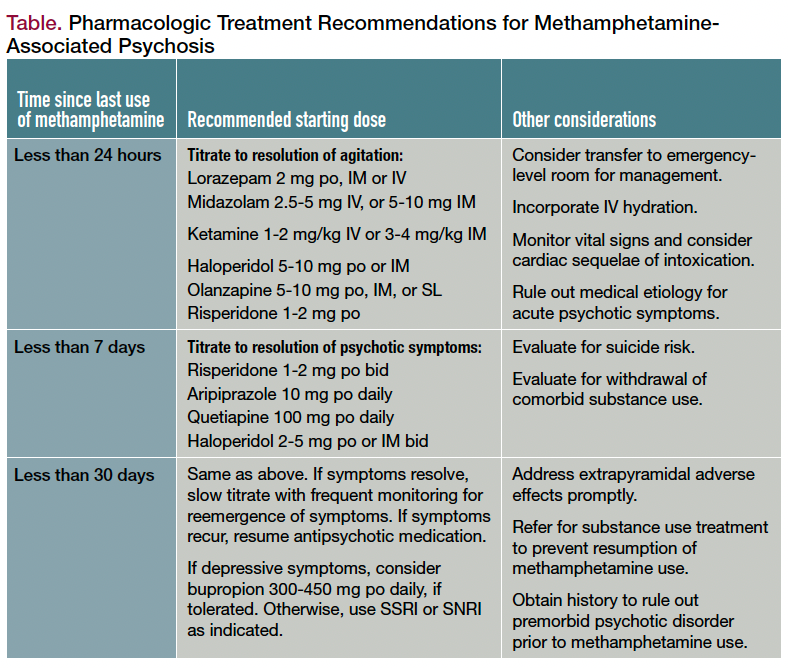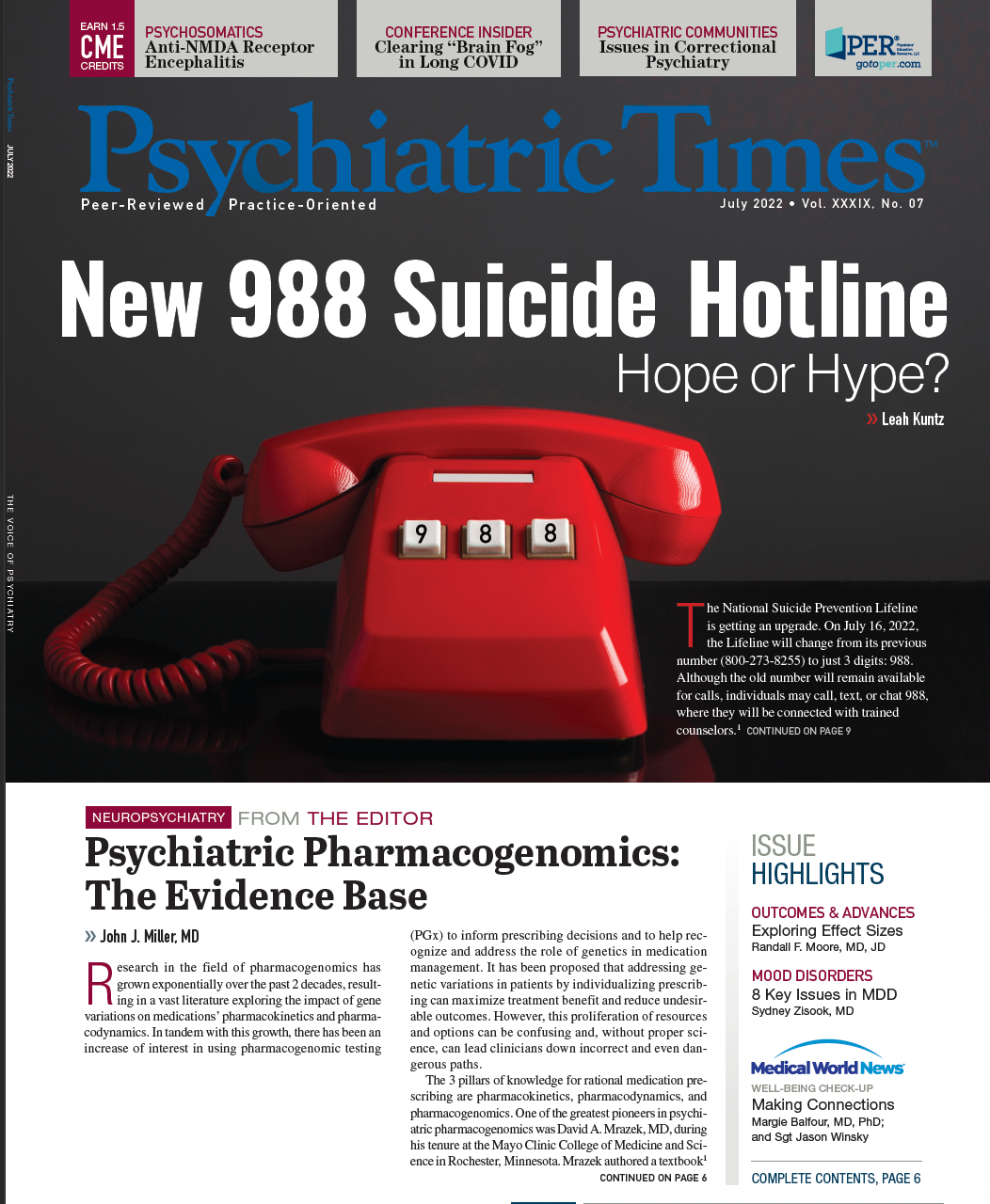Publication
Article
Psychiatric Times
Methamphetamine-Associated Psychosis: What Should Clinicians Know?
Author(s):
Exploring the association between methamphetamine use and the development of psychotic symptoms, such as paranoid delusions, ideas of reference, and auditory hallucinations.
Илья Подопригоров_AdobeStock

Clinical Vignette
A 27-year-old man presents to an outpatient psychiatrist for intake 5 days after discharge from an inpatient psychiatric hospitalization. He had no prior psychiatric history until 10 days before the appointment, when he was brought to the emergency department (ED) by police after his landlord called 911. The landlord told police that the patient was acting unusually, making verbal threats to other tenants, and expressing paranoid and persecutory beliefs. He required ketamine 200 mg IM before he was cooperative enough to accept IV fluid hydration. Medical work-up was within normal limits, and urine toxicology testing was positive for methamphetamines.
During the ED evaluation, he became increasingly depressed, reporting suicidal ideation and continued auditory hallucinations. He was admitted to an inpatient psychiatric unit, where he was prescribed risperidone 1 mg orally twice per day. Over the course of his hospitalization, he reported remission of suicidal ideation as well as improvement in hallucinations and his level of paranoia. He was discharged on hospital day 5. At the initial outpatient assessment, he reported adherence with risperidone since discharge and denied any psychotic symptoms. However, he was experiencing sedation during the day. Although he endorsed cravings for methamphetamine, he said he was committed to not resuming substance use. Citing the adverse effects he was experiencing, he wanted to know if he could safely discontinue the antipsychotic medication.
Background
Methamphetamine use in the United States is a growing problem, with approximately 1.6 million adults using it yearly.1 It can be taken orally, nasally, or intravenously to produce euphoria and mood elevation. Acute intoxication can lead to increased mental acuity and reduction in appetite.2 It can also inhibit fatigue, which is why it is used concomitantly with sedating substances of abuse such as alcohol or opioids. Withdrawal is associated with somnolence, reduced cognitive ability, and dysphoric or irritable mood, which can contribute to the increased risk of suicide.
There is a robust association between methamphetamine use and the development of psychotic symptoms, such as paranoid delusions, ideas of reference, and auditory hallucinations. Clinical observations suggest that there are 2 distinct types of methamphetamine-associated psychosis (MAP): Some patients have quick resolution of psychotic symptoms with cessation of substance use, but for other patients, psychotic symptoms are slow to remit. In 1 cross-sectional study, more than half (52%) of patients with MAP saw a remission of their psychotic symptoms within a week of abstinence from methamphetamines. Psychotic symptoms remained in 26% of patients after 1 month and in 16% of patients after 3 months.3 For those patients who present with persistent psychotic symptoms after methamphetamine use has stopped, it remains unclear if they are already genetically vulnerable and methamphetamine use triggers the development of a psychotic disorder. Clinical management of a patient with onset of psychotic symptoms in the context of methamphetamine use may present a challenge for psychiatric providers in an ambulatory, longitudinal treatment setting.
Biologic Basis of MAP
Our current understanding of the biology of MAP suggests 2 possible scenarios for a clinician to consider. The first is that methamphetamine use causes acute changes that result in psychosis that will remit as methamphetamine use remits. The second is that methamphetamine use can cause permanent psychosis, either through direct changes to previously normal brain function or through unmasking a genetic vulnerability to psychosis.
The effects of methamphetamine use on the central nervous system are primarily mediated through dopaminergic transmission—the same system thought to play a major role in schizophrenia and other related disorders. The rewarding effects of substances are also mediated through dopaminergic pathways in the mesolimbic system. Methamphetamine inhibits dopamine (DA) reuptake through inhibition of the DA transporter and the vesicular monoamine transporter. This leads to elevated concentrations of DA, potentially to neurotoxic levels. Higher dopaminergic signaling in the mesolimbic, nigrostriatal, and mesocortical pathways causes elevated glutamate levels that damage GABAergic interneurons. This leads to glutamate dysregulation and impairment of N-methyl-D-aspartate receptors, resulting in damage to the cortex and the onset of psychotic symptoms.4
Neuroimaging studies demonstrate structural changes in the brains of patients who develop psychosis with the use of methamphetamine compared with those who do not develop psychosis.5,6 Changes in these brain regions have also been seen in patients with primary psychotic disorders.
Genetic studies also suggest an overlap in genes associated with the development of primary and methamphetamine-associated psychosis.7 Using a stress-vulnerability model of psychosis in which methamphetamine is an additional “hit” or stressor precipitating the onset of psychotic symptoms, the amount, frequency, and duration of drug use needed to cause MAP could vary greatly based on the individual’s genetic vulnerability.8
Approach to Treatment
Management in the acute setting: Acute onset of psychotic symptoms in a previously healthy individual requires a comprehensive evaluation. In addition to brain imaging, laboratory work including basic metabolic panel, HIV, rapid plasma reagin, and thyroid stimulating hormone can help rule out possible medical causes. IV fluids may be necessary to replace fluid loss and to address hyperthermia caused by methamphetamine intoxication.
Withdrawal from alcohol or benzodiazepines can present with psychosis, and because methamphetamine is often used in conjunction with other substances, this should be included on the differential diagnosis. Benzodiazepines are the preferred treatment in this situation, and they are used as first-line agents in the treatment of patients with agitated psychosis. Ketamine is widely used for sedation in emergency department settings and can be administered intravenously or intramuscularly.9 Both first- and second-generation antipsychotic medications can be used in acute management of agitated psychosis, often in conjunction with anticholinergic medications to prevent possible extrapyramidal symptoms.
Treatment of prolonged psychosis: Because MAP involves many of the same dopaminergic circuits as primary psychotic disorders, it is no surprise that many of the same antipsychotic medications can be effective in both conditions. However, it is important to recognize that psychotic symptoms related to methamphetamine use may remit with cessation of substance use, so continuous use of antipsychotic medications may not be necessary. Antipsychotic medications are associated with abnormal movements that can be permanent. They are also associated with metabolic adverse effects that can increase the risk for cardiovascular disease. The potential benefits from continuing an antipsychotic medication in a patient with MAP must be weighed against these potential risks.
A clinician should gather appropriate history to determine if psychotic symptoms or a psychotic prodrome was present prior to methamphetamine use. If there is no evidence of a preexisting psychotic disorder and if psychotic symptoms have remitted with cessation of methamphetamine use, it is reasonable to try tapering the antipsychotic medication. Patients should be seen frequently during this period to assess for the reemergence of psychotic symptoms. It can also be helpful to include a family member or other source of collateral information who can report symptoms they might observe as the antipsychotic is discontinued. Negative symptoms are less commonly seen in methamphetamine-induced psychosis, and if noted on exam, they would suggest that a primary psychotic disorder requiring ongoing treatment is more likely.10
Studies suggest that second-generation antipsychotic medications are preferred over first-generation in the treatment of MAP. Haloperidol and olanzapine have comparable effects with regard to psychotic symptoms; however, patients treated with olanzapine appear to tolerate the medication better due to fewer extrapyramidal adverse effects.11 Haloperidol and quetiapine have also been shown to have comparable therapeutic effects.12
In a study comparing risperidone and aripiprazole, both medications resulted in improvement in psychotic symptoms. Participants treated with both medications reported decreases in subjective rating of cravings, although this effect was more robust in the risperidone-treated group. In addition, the dropout rate was higher and tolerability of the drug was lower in the group treated with aripiprazole, suggesting risperidone would be the preferred agent out of the 2 studied.13
The evidence that antipsychotic medications, particularly second-generation antipsychotics, may reduce craving for methamphetamine suggests a role for these medications as first-line treatment in MAP. Pharmacological treatment recommendations for MAP are summarized in the Table.
Table. Pharmacologic Treatment Recommendations for Methamphetamine-Associated Psychosis

More research is warranted to further explore the efficacy of different antipsychotic medications to treat MAP.
Cessation of methamphetamine use: Treatment of MAP should focus both on alleviating the psychiatric symptoms as well as promoting abstinence from methamphetamines. The treatment of methamphetamine use disorder is challenging even in patients who have not presented with psychotic symptoms, as there are currently no US Food and Drug Administration (FDA)- approved medications for this indication.
Because replacement therapy has been successful in the treatment of other substance use disorders such as opioid and tobacco use disorder, numerous studies have explored a role for pharmacologically produced amphetamines to treat methamphetamine use; however, the results so far seem to be disappointing.14 N-acetylcysteine has been studied as a potential treatment but is currently not recommended as a treatment for this patient population.15 In a 2021 study of people with moderate to severe methamphetamine use disorder, those receiving bupropion plus extended-release injectable naltrexone showed a small but significant improvement in methamphetamine-negative urine drug tests compared with those randomized to placebo.16 Oxytocin also has been explored as a possible treatment for a number of substance use disorders, including methamphetamine; the results suggest that oxytocin may be able to augment psychosocial treatments such as group therapy to increase efficacy in substance use disorder treatment.17
Nonpharmacologic treatments form the current basis for treatment of methamphetamine use disorder at this time. Psychotherapeutic interventions such as cognitive behavioral therapy and contingency management have shown promise in the treatment of methamphetamine use disorder.18 Although these treatment modalities have not been studied specifically in the MAP population, they may show some promise, particularly in medication-resistant patients. Mindfulness-based relapse prevention (MBRP), which has been shown to reduce relapse in several substance use disorders, has been studied in psychotic patient populations and can reduce both positive and negative psychotic symptoms, suggesting its potential benefit in the treatment of MAP.19 Unfortunately, lower than ideal retention in studies of psychotherapeutic treatments suggests a barrier for the effectiveness of these treatments in the absence of other treatments that target physiological craving.20
Concluding Thoughts
As methamphetamine use continues to grow worldwide, mental health providers will encounter MAP with greater frequency in various clinical settings. Further study on both pharmacological and psychosocial treatment approaches for MAP as well as methamphetamine use disorder is still needed.
Dr Harrington is medical director in the department of Outpatient Psychiatry Services, associate director of the Addiction Psychiatry Fellowship program, and director of quality in the department of psychiatry at UMass Memorial Medical Center. She is also an assistant professor at the University of Massachusetts Chan Medical School. Dr Fan is a professor at the University of Massachusetts Chan Medical School and is affiliated with UMass Memorial Medical Center.
Dr Fan has received research support or honoraria from Alkermes, Allergan, Avanir, Boehringer Ingelheim, Janssen, Lundbeck, Neurocrine, and Otsuka. Dr Harrington reports no competing interests.
References
1. Jones CM, Compton WM, Mustaquim D. Patterns and characteristics of methamphetamine use among adults - United States, 2015-2018. MMWR Morb Mortal Wkly Rep. 2020;69(12):317-323.
2. Courtney KE, Ray LA. Methamphetamine: an update on epidemiology, pharmacology, clinical phenomenology, and treatment literature. Drug Alcohol Depend. 2014;143:11-21.
3. Iwanami A, Sugiyama A, Kuroki N, et al. Patients with methamphetamine psychosis admitted to a psychiatric hospital in Japan. a preliminary report. Acta Psychiatr Scand. 1994;89(6):428-432.
4. Hsieh JH, Stein DJ, Howells FM. The neurobiology of methamphetamine induced psychosis. Front Hum Neurosci. 2014;8:537.
5. Uhlmann A, Fouche JP, Koen N, et al. Fronto-temporal alterations and affect regulation in methamphetamine dependence with and without a history of psychosis. Psychiatry Res Neuroimaging. 2016;248:30-38.
6. Yimsaard P, Maes MM, Verachai V, Kalayasiri R. Pattern of methamphetamine use and the time lag to methamphetamine dependence. J Addict Med. 2018;12(2):92-98.
7. Grant KM, LeVan TD, Wells SM, et al. Methamphetamine-associated psychosis. J Neuroimmune Pharmacol. 2012;7(1):113-139.
8. Bramness JG, Rognli EB. Psychosis induced by amphetamines. Curr Opin Psychiatry. 2016;29(4):236-241.
9. Hopper AB, Vilke GM, Castillo EM, et al. Ketamine use for acute agitation in the emergency department. J Emerg Med. 2015;48(6):712-719.
10. Chen CK, Lin SK, Sham PC, et al. Pre-morbid characteristics and co-morbidity of methamphetamine users with and without psychosis. Psychol Med. 2003;33(8):1407-1414.
11. Leelahanaj T, Kongsakon R, Netrakom P. A 4-week, double-blind comparison of olanzapine with haloperidol in the treatment of amphetamine psychosis. J Med Assoc Thai. 2005;88(suppl 3):S43-S52.
12. Verachai V, Rukngan W, Chawanakrasaesin K, et al. Treatment of methamphetamine-induced psychosis: a double-blind randomized controlled trial comparing haloperidol and quetiapine. Psychopharmacology (Berl). 2014;231(16):3099-3108.
13. Wang G, Zhang Y, Zhang S, et al. Aripiprazole and risperidone for treatment of methamphetamine-associated psychosis in Chinese patients. J Subst Abuse Treat. 2016;62:84-88.
14. Chan B, Freeman M, Kondo K, et al. Pharmacotherapy for methamphetamine/amphetamine use disorder-a systematic review and meta-analysis. Addiction. 2019;114(12):2122-2136.
15. McKetin R, Dean OM, Turner A, et al. A study protocol for the N-ICE trial: a randomised double-blind placebo-controlled study of the safety and efficacy of N-acetyl-cysteine (NAC) as a pharmacotherapy for methamphetamine (“ice”) dependence. Trials. 2019;20(1):325.
16. Trivedi MH, Walker R, Ling W, et al. Bupropion and naltrexone in methamphetamine use disorder. N Engl J Med. 2021;384(2):140-153.
17. Stauffer CS, Moschetto JM, McKernan S, et al. Oxytocin-enhanced group therapy for methamphetamine use disorder: randomized controlled trial. J Subst Abuse Treat. 2020;116:108059.
18. AshaRani PV, Hombali A, Seow E, et al. Non-pharmacological interventions for methamphetamine use disorder: a systematic review. Drug Alcohol Depend. 2020;212:108060.
19. Louise S, Fitzpatrick M, Strauss C, et al. Mindfulness- and acceptance-based interventions for psychosis: our current understanding and a meta-analysis. Schizophr Res. 2018;192:57-63.
20. Stuart A, Baker AL, Bowman J, et al. Protocol for a systematic review of psychological treatment for methamphetamine use: an analysis of methamphetamine use and mental health symptom outcomes. BMJ Open. 2017;7(9):e015383. ❒






